I have long considered the Volkswagen Beetle to be the automotive equivalent of the Lego block. Both emerged from their respective factories in enormous numbers and are extraordinarily versatile. Like the children’s toy, the long production life and evolutionary changes performed by Volkswagen mean that there are endless possibilities to mix and match parts from various eras. This 1967 Beetle demonstrates that ability, featuring upgrades to improve its performance and handling. It is a turnkey proposition, although the new owner could treat it to a cosmetic refresh so its looks match its performance. The Volkswagen is listed here on eBay in Birmingham, Alabama. Solid bidding has pushed the price to $2,125 in a No Reserve auction.
I would describe this Beetle’s presentation as tidy but not outstanding. Its panels wear Zenith Blue paint that shows its age. There are minor marks and scratches, and it has lost the hard edge to its shine. The panels sport a few little bumps and bruises. Those factors combine to suggest a cosmetic refresh would make an enormous difference to its overall appearance. There is no visible rust, and the seller doesn’t mention any hidden problems with the floors or other prone areas. Addressing existing issues (if there are any) should not be complicated because parts are readily available and affordable. The glass and trim are generally pretty good, but some seals show deterioration. The muffler poking from the rear makes the car look like a fat little puppy, but since it is also a tripping hazard, I would probably seek a more appropriate solution. The lowered ride height and aftermarket wheels suggest there could be more to this classic than first meets the eye.
This car’s drivetrain configuration is standard Beetle fare, with a rear-mounted air-cooled flat-four feeding its power to the rear wheels via a four-speed manual transaxle. It would have rolled off the showroom floor with a 1,192cc powerplant producing 53hp and 78 ft/lbs of torque. Outright performance was never the stated goal with the Beetle, with the company’s focus on its ability to cruise effortlessly for hours at 60mph. Volkswagen achieved that goal admirably, but this car brings extra performance to the table courtesy of an engine upgrade. Its four has been pushed to 1,641cc, featuring a hot camshaft and an electric fuel pump feeding the Dellorto carburetor. Spent gases exit via an exhaust featuring J Tubes and the custom muffler I’ve already mentioned. The mechanical package was completed by dropping the ride height to improve the car’s handling and grip. We receive no information on the power output or how this Volkswagen drives, but the motor has only clocked around 10,000 miles since being built. The bulletproof nature of these components and the seller’s description of it as a “weekend warrior” suggests the news should be positive.
The Beetle’s interior is tidy and serviceable, with no immediate needs. The winning bidder might replace the front carpet, and some painted surfaces would benefit from a refresh. However, the Black vinyl upholstery and trim are in good order, with no rips or tears. The headliner is clean, and I can’t spot any problems that would justify an interior retrim. If the carpet is the only issue, it would take more time than money to make the interior “pop.” It should also be enjoyable on long journeys because the driver grips a leather-wrapped MOMO wheel, and a modern radio/CD player feeds its sound via a potent Rockford Fosgate amp to provide thumping tunes on the move.
The Volkswagen Beetle is undeniably cool, and this 1967 example shows promise. It won’t appeal to purists, but the mechanical upgrades will improve driving enjoyment. The new owner could preserve it as-is, although treating it to a cosmetic birthday would ensure it turns heads. The bidding has been surprisingly subdued, but that could benefit our readers. The action will probably intensify as the auction draws to a close. If it doesn’t, the No Reserve factor might allow someone to drive away in this classic for a bargain basement price. It might be worth monitoring the auction if a Beetle has been on your radar. This could be your dream car.
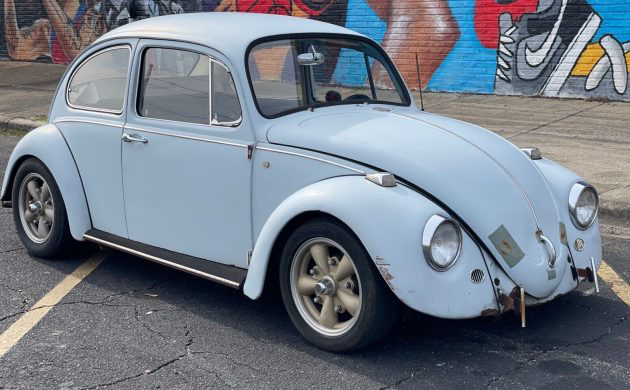
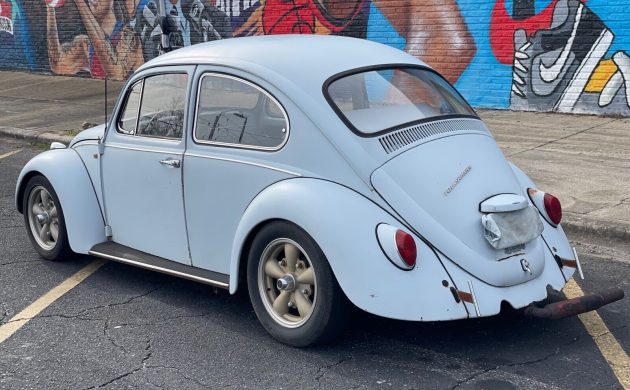
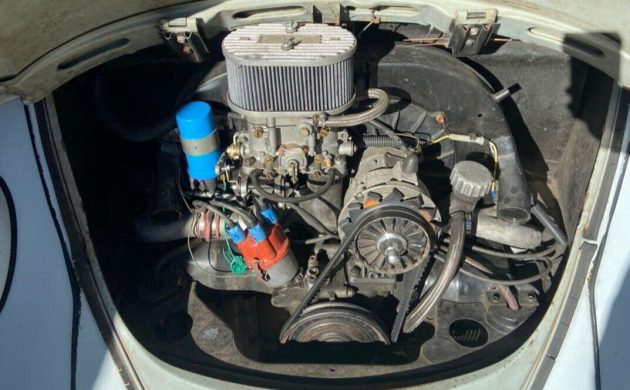
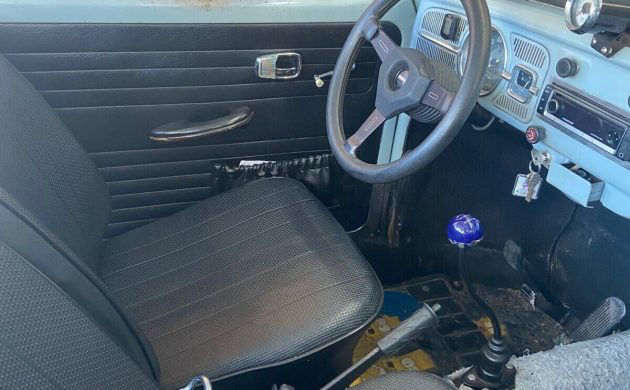
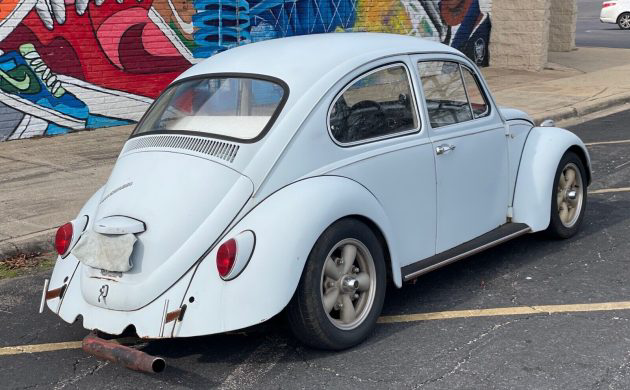




I like it. Paint it, put a better exhaust system on it (plenty of good ones out there), put early bumpers on it and drive it. I’ve driven a lowered Bug and the driving improvement is immense. Looks like fun to me.
Craziest conversion I have seen is a late 50’s bug with a 425 Olds and Toronado transaxle at Iola in the 1980’s. Lingered around the car for a while but never met whoever drove it there. I was fascinated by the potential white knuckle handling characteristics. Wonder if it’s still out there
hi Tbone is there any you can tell me what area that you saw the vw with the olds motor in it. I have a friend that built one and would like to have it back. It was silver in color.
Very nice old VW. Back in the day, these cars were about the cheapest fun you could have on 4 wheels. I had a ’68 that had been converted to a Baja bug. I can’t recall if I traded a Chevy van for it, or if I traded it for the van! Drove it for one summer and a blast. So easy to work on, and parts are pretty cheap.
Okay. Had to take a deep breath. I had a ‘67, same color. I lived in Birmingham at the time. I imagined if this was the one I owned the ‘since that time’ owners have fallen on hard times. Mine was in really decent condition. Then I noticed no BUCKNELL UNIVERSITY sticker on the back windshield. Goodness I miss that little chirpy engine noise!
The 67 came with a 1500cc engine, not a 1200 as article states.
You are corrrect, but I believe that the 1300cc engine in my ’66 was the best engine VW ever made, plus the ’66 still had the bug headlights! (not the 12v sealed beams from ’67 on which ruined the looks of the front fenders)
I would expect some rust along the heater channels where the running boards are attached to the Bug. I think I see rust under the bottom hinge on the driver side and the passenger side. Not overly difficult to repair but may require some cutting and welding work. Plus new running boards. Would be pulling off anyway if you paint. Plus the other decision would be removing the fenders to paint separately and reattach and might as well fix running boards. So cost to refresh will be determined by your ability to fix the dents and whether you overspray or pull all the fenders and hood and repaint in that style.
For this car…leave the the running boards in the cylindrical filing system.
I drove my newly painted Bug (without running boards) home from the body shop thinking “it’s not very far”. Those running boards stop the rocks that the front wheels throw up from hitting the rear fenders.
Had an early 70’s as part of a job payment and ran it on a farm/airfield as a beater- until one day I arrived to find the entire body off the frame upside down near some burnt grass. Fun while it lasted, and probably more fun to whoever stole the frame and motor for what I guessed would be a buggy build
I had 2 of these when I was a kid – a 66 and a 68, and they were the greatest. The 66 I stripped off all the chrome trim and painted it with rattle-can brown primer (10 cans or so?) and a white stripe down the middle (Hershey Bar version). The 68 blew the engine and I fixed it myself without having any idea what the hell I was doing (teenager at the time) and it ran for another zillion miles. They would go anywhere (snow, mud, across streams, …) I think they’re cool the way the are and for the purpose they were designed for, so I’d just buy this, get it running well, and enjoy it. They are cheap and fun. Anyone (other than a collector) who cares about the rest may be missing the point, IMHO.
Great car lots of modern stuff..12 volts, double master cylinder.great driver for all year round in the southern states.8 months in north
…country…We used to race them on a frozen lake in VT in winter back in the late 60’s..no worry about breaking through the ice…they floated for 27+ min